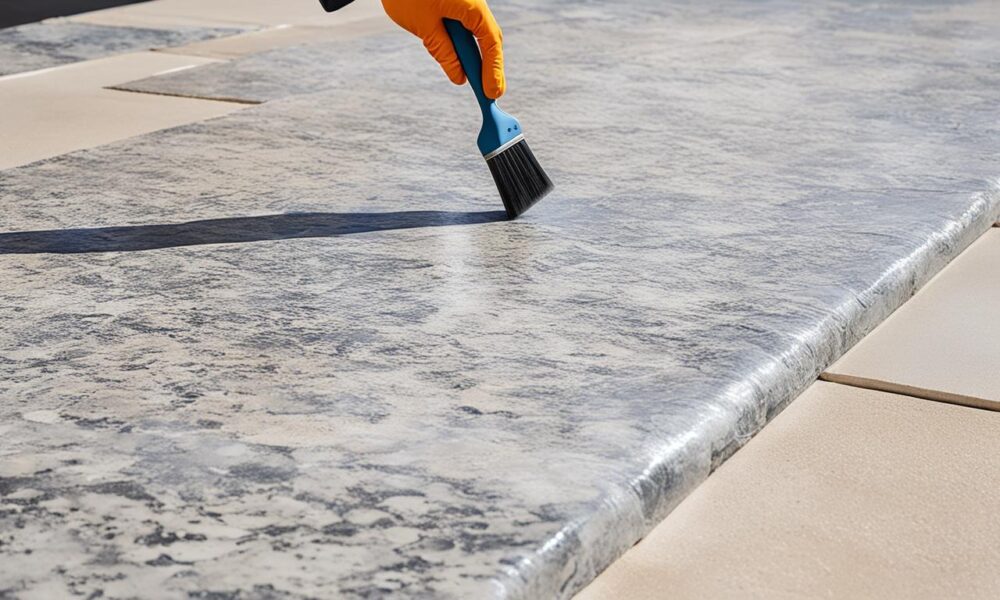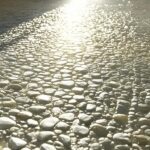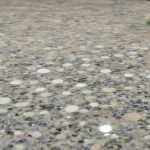Avoid These Natural Stone Maintenance Mistakes
Natural stone adds beauty and durability to any home. But, to keep it looking great, you must avoid common mistakes. It’s important to clean stone surfaces right to stop etching, staining, and damage.
Natural stone is tough, but not invincible. Using the wrong cleaners can dull and harm it. Not sealing stone makes it prone to stains and moisture damage. Keeping up with maintenance and cleaning spills quickly is crucial.
Knowing how to seal stone and clean it right helps avoid big mistakes. This article will show you how to keep your natural stone looking good for years. We’ll cover the main mistakes to avoid in caring for natural stone.
Key Takeaways
- Use pH-neutral cleaners specifically designed for natural stone
- Avoid acidic cleaning agents like vinegar and harsh chemicals
- Seal natural stone surfaces every 3-5 years, depending on the stone type
- Clean spills immediately to prevent etching and staining
- Use soft microfiber cloths for cleaning instead of abrasive tools
- Place rugs and mats in high-traffic areas to minimize wear
- Establish a regular cleaning routine for optimal maintenance
Understanding the Importance of Proper Natural Stone Care
Natural stone surfaces like granite countertops and travertine floors add elegance to any space. But, they need the right care to stay beautiful and last long. New treatments have made them more durable against. Still, regular cleaning and care are key.
Each type of natural stone has its own needs. Marble floors need careful cleaning to avoid scratches and stains. Granite floors, however, are tough and great for busy areas like kitchens.
Limestone and travertine need extra attention because they are porous and react to acids. Travertine floors look best with careful cleaning. Limestone requires constant attention to avoid stains and chips.
“There is a chemistry to natural stone, and making mistakes can harm it,” notes Tim Lesnar, owner of Classic Marble Restoration in Blaine, Minnesota.
Wrong cleaning methods can ruin the beauty of natural stone. Common mistakes include:
- Using harsh cleaners that can etch, discolor, and damage sealants
- Scrubbing with abrasive tools that scratch the stone
- Applying acidic cleaners like vinegar that can damage the sealant
- Soaking the stone floor, which can cause water damage
To keep natural stone looking great, use cleaners that are pH-neutral and soft sponges or brushes. Clean regularly and deal with spills quickly to avoid damage. This prevents black spots from forming.
Sealing natural stone is also crucial. Not sealing it makes it prone to stains and damage. Sealing protects against wear, UV rays, pollution, and frost. The sealing frequency varies by stone type, with porous stones needing more frequent reapplication.
| Stone Type | Sealing Frequency |
|---|---|
| Granite | Every 1-2 years |
| Marble | Every 6-12 months |
| Travertine | Every 1-2 years |
| Limestone | Every 6-12 months |
By knowing how to properly care for natural stone, including cleaning, sealing, and avoiding mistakes, you can keep your stone surfaces beautiful for a long time.
Using the Wrong Cleaning Agents
Many homeowners make a big mistake when cleaning their natural stone surfaces. They use cleaners not made for natural stone, which can damage it. It’s important to pick the right cleaners to keep your stone looking great.
Acidic Commercial Cleaners and Harsh Chemicals
Using cleaners with bleach or other harsh chemicals can harm natural stone. These cleaners can remove the sealer, making the stone prone to stains and damage. Always choose cleaners that are pH-neutral and made for stone surfaces. The Stone Collection has many stone options and can help you find the best cleaner for your stone.
Vinegar and Other Acidic Household Alternatives
Vinegar might seem like a good cleaner, but it can hurt some stones like marble and limestone. These stones have calcium carbonate and can be etched by vinegar and other acids. To keep your stone looking good, don’t use these acids. Choose cleaners that are pH-neutral instead.
| Cleaning Agent | Effect on Natural Stone |
|---|---|
| Vinegar | Can lead to burning or etching on limestone, marble, and travertine |
| Bleach | Strips away protective sealer and dulls the surface |
| Lemon Juice | Etches and damages the surface of marble and limestone |
| Ammonia-based Cleaners | Can etch and damage certain types of natural stone |
Etching and Its Effects on Natural Stone
Etching is a damage that looks like dull marks on natural stone. It happens when something acidic touches the stone, causing a reaction that wears it down. Marble and other calcium carbonate stones are especially at risk.
To stop etching and keep your stone looking nice, avoid acidic cleaners. If you’re unsure, talk to a pro like The Stone Collection. They can help you pick the right products for your stone.
Choosing the Right Cleaning Tools
Choosing the right tools is key to keeping your natural stone surfaces looking great and lasting long. The wrong tools can scratch, etch, and wear out the stone too fast. This can ruin its look and strength.
Avoiding Abrasive Sponges, Brushes, and Scouring Pads
Abrasive sponges, brushes, and scouring pads harm softer stones like marble and soapstone. Even on harder stones like granite, they can wear away the sealer. This makes the stone prone to stains and moisture damage.
Some people think scrubbing pads help with etches or stains, but they don’t. These pads scratch and dull the stone, taking away its beauty.
Soft Microfiber Cloth for Effective and Safe Cleaning
For keeping your stone surfaces in top shape, go for gentle cleaners and tools. A soft microfiber cloth is perfect for picking up dirt and dust without harming the stone. It’s great at cleaning stone without damaging it.
| Cleaning Tool | Effect on Natural Stone | Recommended Usage |
|---|---|---|
| Abrasive Sponges, Brushes, and Scouring Pads | Can scratch, etch, and prematurely wear away protective sealers | Avoid using on all natural stone surfaces |
| Soft Microfiber Cloth | Effectively captures dirt, dust, and debris without causing damage | Highly recommended for safe and efficient cleaning of natural stone |
By picking the right tools and methods for cleaning stone, you can keep your stone looking good for a long time. Always choose gentle cleaners and soft microfiber cloths. This helps keep the stone’s natural look and protects it from damage.
Establishing a Regular Cleaning Routine
To keep your natural stone surfaces looking great, like granite countertops and travertine floors, you need a regular cleaning plan. How often you clean depends on where the surface is and how much it gets used. For example, clean kitchen countertops daily to stop stains and damage from moisture. Clean them deeply with a good natural stone cleaner once a week.
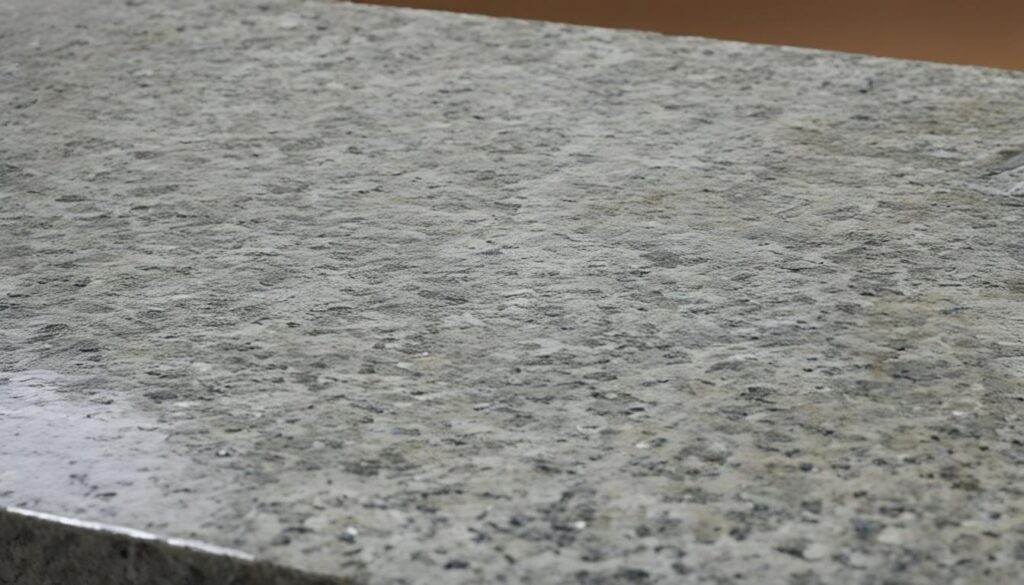
For natural stone floors, it’s key to mop regularly to get rid of dirt and debris. This helps prevent scratches and wear. Mop your floors once a week, but more often if they get a lot of foot traffic. Regular mopping can cut down on dirt and debris by up to 90%.
Roughly 80% of damage to natural stone surfaces is caused by improper cleaning and maintenance.
To keep your natural stone looking great, follow these cleaning tips:
- Sweep or dust surfaces daily to remove debris and prevent scratches
- Wipe up spills right away to stop stains, as quick action can prevent up to 70% of stains from lasting
- Clean surfaces weekly or as needed with gentle cleaners and methods
- Dry surfaces well after cleaning to stop up to 75% of hard water stains
| Surface Type | Cleaning Frequency |
|---|---|
| Kitchen Countertops | Daily wiping, weekly deep cleaning |
| Natural Stone Flooring | Weekly mopping, more frequent in high-traffic areas |
| Bathroom Vanities | Daily wiping, weekly deep cleaning |
By cleaning your natural stone regularly, you can keep it looking beautiful and make it last longer. Use the right cleaning methods for stone and avoid harsh chemicals or rough tools. These can cause up to a 60% increase in scratches and discoloration.
Proper Sealing Techniques for Natural Stone
Natural stone surfaces like marble, granite, and travertine need the right seal to stay beautiful and strong. Sealing them stops etching and staining from acidic substances and daily wear. By choosing the right sealant and applying it correctly, your natural stone can stay protected and look great for many years.
Importance of Sealing and Resealing
Sealing your natural stone is key for several reasons. It prevents stains by creating a barrier against liquids and other substances. This is crucial for stones like marble, limestone, and travertine, which soak up spills easily and can stain.
Sealing also guards against etching. This happens when acids touch the stone, making it dull or rough. Resealing is just as important because the sealant’s protective layer can fade over time. Experts suggest resealing every 1-3 years, based on the stone type and how much it’s used.
Professionals have trusted Maxisil Natural Stone sealant for over 23 years. It offers top protection against stains and mold, thanks to its fungicides and special formula. It’s great for many stones, like marble and granite, as well as flooring, pavers, facades, and joints.
Frequency of Sealing Based on Stone Type
How often you need to seal your natural stone depends on its porosity and type. Some stones are more porous and need sealing more often to stay protected. Here’s a guide to help you figure out when to seal your stone:
- Granite: Every 1-3 years
- Marble: Every 6-12 months
- Limestone: Every 6-12 months
- Travertine: Every 1-2 years
- Slate: Every 1-2 years
- Soapstone: Every 1-3 years
| Stone Type | Geological Classification | Characteristics |
|---|---|---|
| Granite | Igneous | Siliceous, resistant to acids |
| Marble | Metamorphic | Calcareous, sensitive to acids |
| Limestone | Sedimentary | Calcareous, sensitive to acids |
| Travertine | Sedimentary | Calcareous, sensitive to acids |
| Slate | Metamorphic | Siliceous, resistant to acids |
| Soapstone | Metamorphic | Siliceous, resistant to acids |
Always follow the sealant’s instructions when applying it. Most sealants need a clean, dry surface before use. Let the sealant cure for 24-72 hours for the best bonding and protection. Sealants make cleaning easier and protect against stains and etching. But, regular cleaning and quick action on spills are still needed to keep your stone looking great.
Addressing Spills and Stains Promptly
Keeping your natural stone surfaces looking great is key. Natural stone can etch and stain easily, especially with acidic things like wine or cleaning products. Quick action and the right cleaning methods can stop permanent damage to your stone tiles.
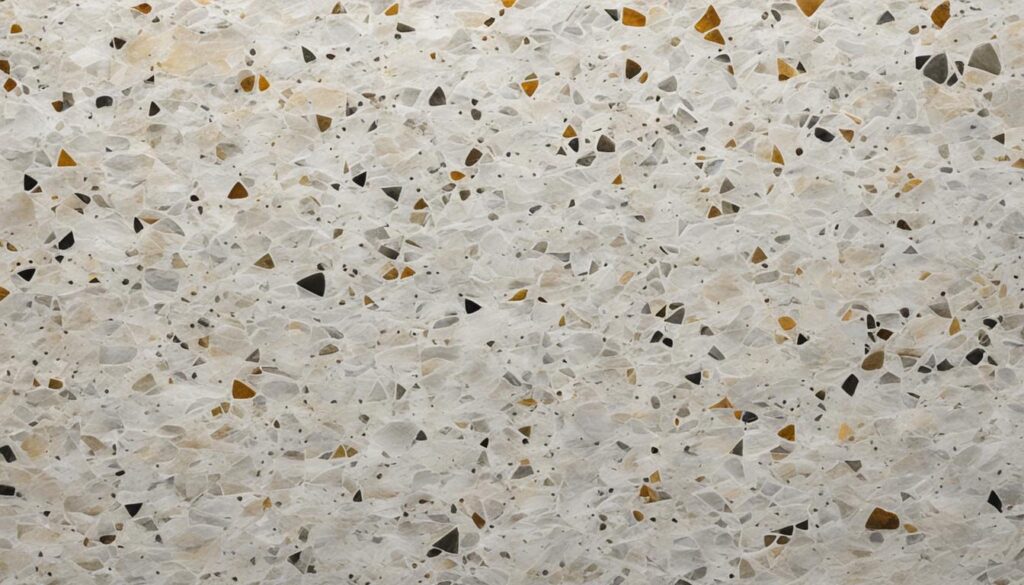
Act fast when you spill something to avoid stains or etching. The longer a spill sits, the deeper it can go into the stone. This can lead to discoloration or chemical reactions. Not cleaning spills quickly can also bring in dirt, making them harder to clean later.
Here are some tips for cleaning spills and stains safely:
- Figure out what spilled to pick the best cleaning method
- Use a stone cleaner that’s pH-neutral for natural stone
- Avoid harsh chemicals or acidic cleaners that can damage the stone
- Blot spills with a soft cloth instead of wiping to stop spreading it
- For hard stains, use a soft brush to gently clean the area
“The key to preventing etching and staining on natural stone surfaces is to act quickly and use gentle, appropriate cleaning methods. By doing so, you can maintain the beauty and durability of your stone tiles for years to come.” – Sarah Thompson, Natural Stone Expert
Remember, different stones absorb spills and stains at different rates. For example, stones like limestone and sandstone stain easily, while granite or quartzite are less prone. Knowing your stone’s nature helps you clean it right to prevent stains and etching.
Protecting High-Traffic Areas with Rugs and Mats
Keeping your natural stone floors looking great is key, especially in high-traffic areas. Using mats at entrances and area rugs in busy spots can help. These items catch dirt and grit that can scratch your stone floors.
Placing Mats at Entrances to Trap Dirt and Debris
Placing mats inside and outside entrances is a smart move. They catch dirt and sand before it hits your stone floors. This reduces scratches and etching over time.
Choose durable, easy-to-clean mats for entrances. Clean them often to keep them working well. For more tips on stone care, see this article on common mistakes to avoid when cleaning natural stone.
Using Area Rugs and Runners in Busy Spaces
Area rugs and runners also protect your stone floors in high-traffic areas. These spots, like hallways and kitchens, see a lot of foot traffic. They can damage your stone. Rugs and runners act as a barrier, keeping your stone safe.
When picking rugs and runners, think about these things:
- Look for rugs with a non-slip backing to prevent accidents and scratches.
- Choose durable, easy-to-clean materials that can handle regular use.
- Pick colors and patterns that match your stone floors and decor.
- Make sure rugs are the right size to cover the area well.
By placing rugs and runners in busy spots, you keep your stone floors looking great. Clean them often to stop dirt from scratching your stone.
Protecting your natural stone floors in high-traffic areas is key. Mats at entrances and rugs in busy spots help. They reduce daily wear and tear on your stone.
Using these tips in your cleaning routine keeps your natural stone floors beautiful and long-lasting.
Common Mistakes to Avoid in Natural Stone Maintenance
Keeping natural stone surfaces looking great requires avoiding common mistakes. One big mistake is using the wrong cleaners. Things like acidic cleaners or harsh chemicals can damage the stone. Even simple things like vinegar can harm certain stones like marble, travertine, and limestone. Always use cleaners made for natural stone with a neutral pH level.
Using the wrong cleaning tools is another mistake. Tools like abrasive sponges or scouring pads can scratch the stone. Instead, use soft cloths or brushes that are gentle. Cleaning regularly helps stop dirt and stains from building up.
Sealing your stone correctly is also important but often done wrong. Sealing protects the stone from stains and damage. But, using the wrong sealant or applying it wrong can cause problems. The type of stone and how often you need to seal it vary. Follow the manufacturer’s advice and use products like RPB Patio Cleaner and RPB Patio Sealer for best results.
Finally, clean up spills and stains right away to prevent them from setting in. Use coasters and mats to catch dirt and keep your countertops clean. By avoiding these mistakes and using the right cleaning methods, your natural stone will stay beautiful for years.

